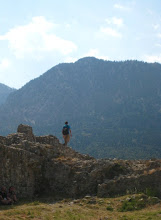The following itinerary I translate from the text produced by Jean Ebersolt in his article that appeared in Byzantinische Zeitschrift over a century ago drawing it from Parisinus 1712 in the Bibliothèque Nationale in France (1). The text is not without interest because it gives us an idea of how long it might have taken a person in the fifteenth century to travel from Cyprus to Iran. Below we reproduce the Greek names in the text followed by the modern names of the cities.
- Un itinéraire de Chypre en Perse d’après le Parisinus 1712. BZ, 15 (1906) pgs. 223-6.
If one desire to go to the place of Uzun Hassan, chiefly his seat (σκαμνίν), where his throne is, that is Ταβρής (Tabriz), one should know how many days it takes one by foot and horseback, so I shall write this for you very precisely.
First you go to Cyprus by vessel and then from the cavo (κάβον) of the island of Cyprus to Τρίπολιν (Tripoli) the crossing is 60 miles. So you cross by a sailing (αρμενισίαν). From there, a man on foot setting out from Tripoli takes three days to get to Χάμα (Hama), while a man on horseback takes one and a half days. From Hama, it takes a man on foot two days and a one on horseback one day to get to Χαλέπιν (Aleppo).
From Aleppo, a man on foot takes two days and a man on horseback one day to get to Μαλατίαν (Malatya).
From Malatya, a man on foot takes two days and a man on horseback one day to get to Τραπυρίαν (?).
From Τραπυρίαν, a man on foot takes three days and a man on horseback a day and a half to get to Χαμίτι (Diarbekir).
From Diarbekir, a man on foot takes sixteen days and a man on horseback 12 days to get to Tabriz, where the seat of Uzun Hassan is.
And so, from Tripoli to the seat of Uzun Hassan, it takes a man on foot 28 days and a man on horseback 18 days to get there.
Unfortunately, I was unable to locate the manuscript’s full description, but according to Ebersolt, this work is contained on four folios of paper appended to the Parisinus 1712, so it may seem likely that perhaps a person on Cyprus or Italy wrote this itinerary though it is an open question (1). It is a well known fact that many Venetians were traveling to Persia to see Uzun Hassan, the chief of the Ak-koyunlu, in the early 1470’s (2). A further point in favor of this is that the author uses κάβον deriving from the Italian cavo meaning the indented part of the island.
As to the voyage itself, it must be remembered that the miles referred to here are Roman miles 4884 feet in length which changes the distance to 55.5 modern miles. It should be noted that the writer seems to lack knowledge of the actual distances he describes. Traveling between Hama and Aleppo is a distance of around 75 miles, so doing it in two days on foot or a single day on horseback is an astonishing feat. The traveler would have been booking it!
- H. Omont, Inventaire sommaire des Mss. Gr. De la Bibl. Nat., II, 128.

No comments:
Post a Comment